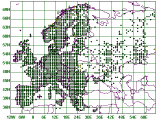
 All MEB-1 records on one map
All MEB-1 records on one map
|
| |
A Reference Locality (RL, plural RLs) is a geographical name contained in the Times Atlas of the World (preferably
9th Comprehensive edition of 1994 or later) unequivocally referable to a certain place on an atlas map by means
of geographical coordinates given in the gazetteer of the Atlas. One RL represents one or several sites of observation,
capture or occurrence of a butterfly species situated in its vicinity and is represented on a distribution map by a dot
or blend together with adjacent RL/RLs into a single dot. Because of the scale of the present maps one RL could cover an
area of up to about 50 × 50 km but a higher density of RLs is advantageous, especially in areas of higher
concentrations of butterflies and their sites. The Times Atlas of the World (9th Comprehensive edition of
1994 or later) was selected because its gazetteer contains geographical coordinates, the maps are updated to show
borders of new and resurrected European states (after the disintegration of the Communist block in 1989) and is
generally the best geographical atlas available at present. The Times Atlas of the World is available in all major
public and many private libraries, and thus enables full reproducibility of RLs. A simplified alphabetic index of
about 8000 RLs was made available to recorders in the MEB handbook (KUDRNA 1996) and a final gazetteer containing
9145 preselected RLs with their geographical coordinates appears in a separate chapter of this book.

 Plebejus argyrognomon (D, Rhoen)
Plebejus argyrognomon (D, Rhoen)
|

 Polyommatus coridon (D, Regensburg)
Polyommatus coridon (D, Regensburg)
| |
For the communication of data by recorders, two sizes of standard Recording Sheets (RS, plural RSs) were devised and
guidelines published (KUDRNA 1996). The standard RSs proved satisfactory as long as recorders followed the instructions
provided and filled them in legibly. Special internal RSs were devised in cooperation with the recorder concerned for
the transfer of extensive data banks (e.g. converted national data banks) and formatted as necessary from case to case.
These special RSs have proved most successful, saved much time and prevented many errors. A few recorders insisted on
a direct input of digital data. From sheer necessity and as a test case, two sets of such data banks were converted and
imported by K. LUX. Both files proved to contain many errors, the correcting of which has probably taken up more time
than the input of the data banks from RSs would have taken. In principle, it is impossible to check such data sets
thoroughly.
|
 Email to Webmaster
Email to Webmaster
 Email to Webmaster
Email to Webmaster